Breaking News: Discover the Chilling Truth Behind Charles-Henri Sanson, the Execution Master of France!
From the days of the sword to the arrival of the guillotine, Charles-Henri Sanson, a name synonymous with execution in 18th-century France, was responsible for the deaths of approximately 3,000 individuals throughout his gruesome career as an executioner. Born in Paris on February 15, 1739, Sanson was not merely the executor; he was part of a long lineage that had served the royal family for generations. His family had been the official executioners of France for three generations, which, during that time, meant more about inherited duty than personal choice.
The turning point in history came on January 5, 1757, when King Louis XV stepped out of the Palace of Versailles and was attacked. A stranger dashed past the royal guards and stabbed the king in the chest with a knife. The assailant was swiftly apprehended, and despite suffering from a relatively minor wound, the king’s thoughts quickly shifted from his own safety to the fate of his would-be assassin. On March 28 of that year, Robert-François Damiens, the unstable religious zealot who had attempted to assassinate the king, faced public execution at Place de Grève, in front of the Hotel De Ville, in Paris. The event turned into a shocking spectacle, where he endured a horrific array of tortures before the eager eyes of an excited crowd.
His flesh was cruelly torn with red-hot iron pincers as a punishment for his crime. The very knife that had been used to attack King Louis was melted into his hand using liquid sulfur. In an even more grotesque display of justice, each limb of Damiens was chained to different horses that were then driven apart, stretching him agonizingly. When, after two agonizing hours, his joints remained intact, the executioner, Charles-Henri Sanson, drew his sword and dismembered Damiens, ultimately setting fire to the still-living torso, reducing the would-be king killer to ashes.

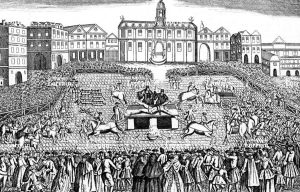
Wikimedia Commons The execution of Robert-François Damiens.
Not surprisingly, accounts from that day, including one from Giacomo Casanovawho happened to be in Paris during this timeindicate that the French population was captivated by the ghastly performance. For the young executioner, Charles-Henri Sanson, it was merely another day at work, illustrating the grim nature of both his profession and the society he served.
Charles-Henri Sanson and the Bloody Code
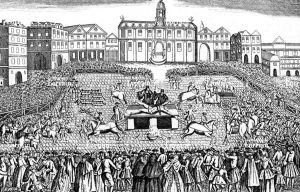
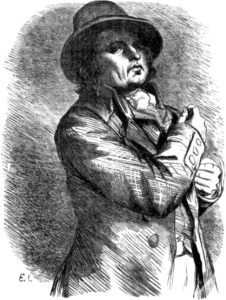
Wikimedia Commons Charles-Henri Sanson
Charles-Henri’s journey as a public executioner began in earnest in 1754 when his father, Charles Jean-Baptiste Sanson, became mysteriously ill, leaving him paralyzed on one side of his body and unable to continue his duties. The elder Sanson retreated to the countryside, leaving his teenage son to navigate the dark and complex waters of their profession. Though Charles-Henri did not formally inherit the title until the death of his father in 1778, he was thrust into a world where the act of execution was surrounded by both horror and ritual.
For centuries, the French justice system adhered to its peculiar hierarchy. Nobles found guilty of severe crimes faced decapitation, often by sword, as this method was deemed cleaner and more efficient than the axe. Commoners, on the other hand, were subjected to hanging a process that involved a complex understanding of mathematics to ensure a swift neck break. The most egregious offenders, such as highwaymen and those who openly defied the sociopolitical order, faced a far more gruesome fate: being broken on the wheel. They would be stretched across the spokes of a cartwheel, and their limbs battered with a mallet before receiving a merciful final blow or left to die slowly, ultimately at the mercy of scavengers.

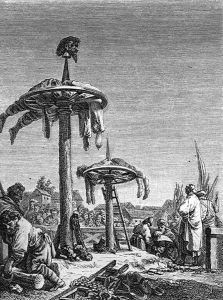
Wikimedia Commons The breaking wheel
To be effective in his chilling duties, a public executioner like Sanson had to master all aspects of the procedureboth its technical execution and its theatrical symbolism. The Monsieur de Paris had to appear at public engagements clad in a striking red cloak that signified his role. Following executions, it was not unusual for sick members of the public to approach the executioner, desperate to touch his blood-stained hands in hope of obtaining his supposed healing powers.
Despite these rather ceremonial aspects of his position, the common populace harbored more fear than respect for executioners. The Sansons, though members of the lower nobility entitled to a fraction of the local market profits, couldnt collect their dues directly due to superstition and the stigma associated with their profession. They had their designated pew in churches, yet it was commonplace for individuals to spit as they passed by the executioner. Interestingly, while they played a vital role in upholding the social order, the Sansons and others like them were treated as outcasts, living a life separated from ordinary society.
This was the grim reality into which Charles-Henri Sanson was born. However, it would not be the world in which he would ultimately perish.
Rumors of Revolution and the Arrival of the Guillotine
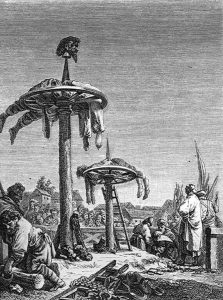
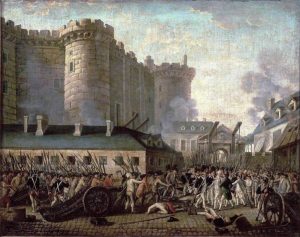
Wikimedia Commons The storming of the Bastille in Paris at the start of the French Revolution.
In 1788, the winds of change began to swirl as Sanson and his sons, Henri and Gabriel, were summoned to oversee the execution of Jean Louschart in the village of Versailles. Louschart had been condemned for brutally murdering his father during a heated argument, and the sentence called for public dismemberment on the wheel close to the royal palace. However, the execution was halted when a group of sympathetic locals stormed the stage, seized the prisoner, and set fire to the wheel as a form of protest.
Although the Sansons managed to escape the wrath of the now-volatile crowd, the very justice system they enforced did not fare as well. With the parliamentary body known as the National Constituent Assembly already engaged in discussions for systemic government change, the events in Versailles illuminated the growing discontent regarding public executions and the role of executioners.
In 1789, as the new government prohibited the privileges and biases once granted to executioners, it proposed a singular method of executiondecapitationreflecting Enlightenment ideals about class equality. However, despite appearing to be a more humane option, the practical implementation of this method was fraught with challenges that only Charles-Henri Sanson could truly appreciate. He knew all too well from experience that delivering a clean decapitation with a sword was a far from easy task. In a particularly humiliating chapter of his career, he had once inadvertently tortured the condemned ex-friend of his father, the Count of Lally, by failing to execute him swiftly in a single blow.
Determined to avoid the potential chaos of a botched execution by inexperienced executioners across the country, Sanson emerged as one of the first supporters of the decapitation machine proposed by Dr. Joseph-Ignace Guillotin. He played a crucial role in its design and testing.
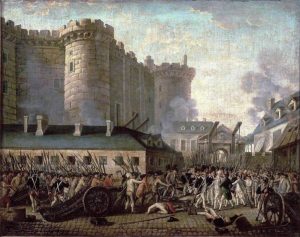
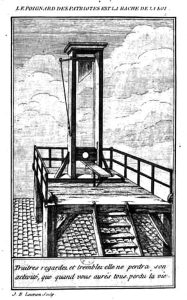
Wikimedia Commons The guillotine
For several months, Sanson, Guillotin, and the Royal Surgeon, Dr. Anton Louis, collaborated on developing the machine’s mechanisms. Allegedly, Sansons friend, the German harpsichordist Tobias Schmidt, finalized the design, constructing the device that would soon change the course of history. Another tale suggests that Dr. Louis, Guillotin, and Sanson even met with King Louis XVIthen under house arrestto seek the royal endorsement. Known for his mechanical inclinations and love of inventions, the king approved the device with one tweak: a change to the blade design from a sharp flat edge to an angled shape for better weight distribution. After trials on bales of hay, pigs, sheep, and even human cadavers, the guillotine was finally ready for its inaugural use.
On April 25, 1792, the guillotine claimed its first victim: Nicolas-Jacques Pelletier, a robber who is said to have been horrified by the new and bizarre execution method.
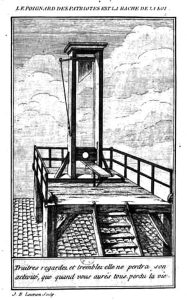
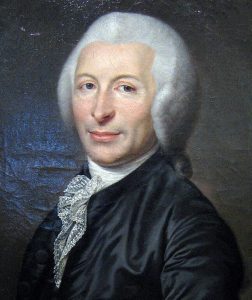
Wikimedia Commons Joseph-Ignace Guillotin
As spectators gathered at Place de Grève to witness the event, they became dissatisfied with the speed and efficiency of the machine, longing for the more dramatic spectacle of traditional hanging. The crowd quickly turned into a furious mob, shouting, Bring back our wooden gallows! Tensions escalated into clashes with the newly formed National Guard, resulting in the deaths of three civilians.
However, it wasnt only the speed of the guillotine that posed unsettling implications. After the execution of Charlotte Cordaya woman who assassinated the revolutionary leader Jean-Paul Marateyewitnesses claimed that her decapitated head changed expressions when slapped by one of Sanson’s assistants. This observation would later lend credence to the unsettling notion confirmed by scientists in the 20th century: that the guillotine executed so swiftly that the decapitated head remained conscious for several moments post-separation.
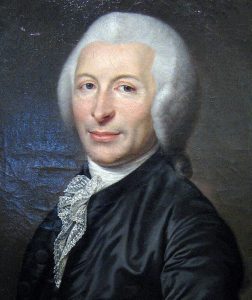

Wikimedia Commons Charlotte Corday
For Charles-Henri Sanson, the feelings regarding the guillotine were deeply personal. On August 27, 1792, shortly after the monarchy collapsed, his son Gabriel tragically fell from the scaffold and died while showcasing a severed head. A few weeks later, tormented by guilt and disturbed by the brutal September massacreswhich led to the deaths of over a thousand prisoners who radical revolutionaries feared might support royalist forces in a counter-revolutionSanson offered his resignation to the new authorities, but it was turned down.
By the following January, both the guillotine and Charles-Henri Sanson were forever etched into history with the execution of Louis XVI.
The King’s Death

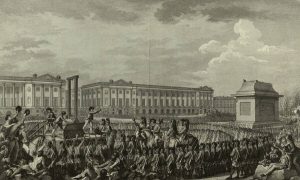
Wikimedia Commons The execution of Louis XVI.
Following the abolition of the monarchy and the royal familys failed attempt to flee France, speculation about the fate of the deposed king swirled. Charles-Henri Sanson, although not particularly politically drivenspending his scarce free time enjoying reading, gardening, and playing the violinconsidered himself, at heart, a monarchist. Louis XVI was the monarch who had officially granted him his role; in a sense, he had become the judge of the king. Without the backing of royal authority, one could argue, how was he any better than the assassins he was tasked with eliminating?
According to the memoirs penned by Charles-Henri Sansons grandson, the night before Louis XVI’s execution, scheduled for January 21, 1793, a threatening message arrived for the Sanson family, claiming a conspiracy was underway to rescue the king. Whether or not the rumor held truth, Sanson made his way to the scaffold at Place de la Révolution (now Place de la Concorde) armed with swords, daggers, four pistols, a powder flask, and pockets filled with bullets, ready to potentially save Louis XVI.
Ultimately, the rescue party never materialized. Instead, Louis XVI was greeted at the national stage by Charles-Henri Sanson amidst the sound of drums. The accusations against the kingof conspiring against the people of Francewere read aloud, to which the king responded with his last words: See, your king is willing to die for you. May my blood cement your happiness. His statement was abruptly cut short by the booming drums. Then, he was laid down on the guillotine, and Sanson performed his grim duty.
Amidst the crowd, the newly liberated citizens of France rushed to collect the kings blood in handkerchiefs, desperate to wash themselves in it. Although rumors arose later suggesting Sanson sold strands of Louis XVIs hair, historical records indicate this is unlikely. In his diary, Sanson recorded: The sacrifice was consummated. However, the French people did not seem any happier.
The Terror

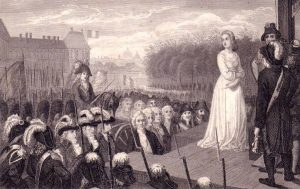
Wikimedia Commons The execution of Marie Antoinette
Under the revolutionary government led by Georges Danton and Maximilien Robespierre, paranoia over perceived internal enemies gave rise to a simplified justice system, resulting in a dramatic increase in executions during 1793 and 1794. Lauded by its creators as The Terror, it was, according to Robespierre, merely swift, severe, and inflexible justice.
This new reality meant that Charles-Henri Sanson found himself busier than ever. Following the execution of Marie Antoinette, Frances deposed queen, the daily number of executions skyrocketed from three or four to dozenssometimes exceeding sixty decapitations in a single day. The stench of blood was so overwhelming on the Place de la Concorde that livestock refused to cross it.
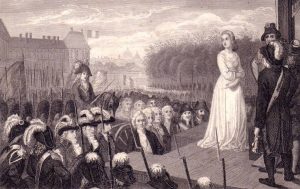
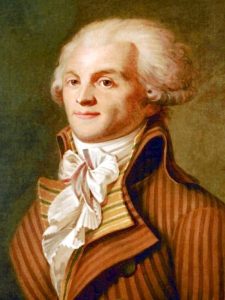
Wikimedia Commons Maximilien Robespierre
As the grim realities of The Terror infiltrated everyday life, Charles-Henri Sanson experienced a shift in his public persona. In the past, people would stop, gawk, and whisper as he passed; now, he was affectionately hailed as Charlot! (little Charles or Charlie) in the streets. There were even discussions about officially titling him “The Avenger of the People,” and his fashion style (green suits) gained popularity among fashionable revolutionaries.
The guillotine itself rose to unprecedented levels of notoriety, surpassing all methods of execution with the exception of the Christian cross. Children began using toy guillotines to execute rats, and the device started appearing on buttons, brooches, and necklaces. For a time, guillotine earrings became a minor trend.
Beneath the surface, however, new struggles emerged. Danton, a populist, and Robespierre, an idealistic demagogue, had always been odd allies, united by a shared revolutionary ambition. Having successfully eliminated most monarchists, remnants of the moderate Girondin party, and even various members of his inner circle, it was only a matter of time before they would turn against each other. Robespierre was the first to strike.
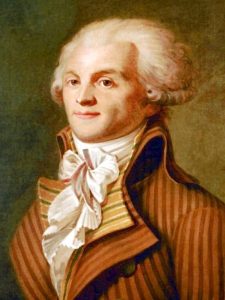
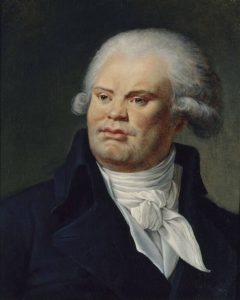
Wikimedia Commons Georges Danton
With growing anti-Danton sentiment within the revolutionary government, Robespierre and his allies soon managed to imprison Danton on charges of corruption and conspiracyprimarily related to alleged financial impropriety and illicit accumulation of wealthon March 30, 1794.
As Danton traveled in the cart of Sanson en route to the scaffold on April 5, he reportedly said, What irritates me most is that I’m going to die six weeks before Robespierre. He was only slightly mistaken in his timing.
The Beginning of the End
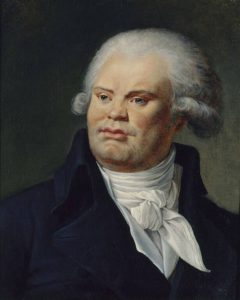
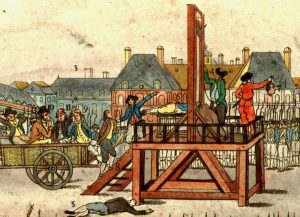
Wikimedia Commons The execution of Robespierre
Robespierres last great hurrah, the Festival of the Supreme Being, took place that June. Having outlawed Catholicism throughout France, he established a national deistic religion, making himself the high priest.
And there stood Charles-Henri Sanson in a place of honor, alongside his son Henri, beside the guillotinerenamed the Holy Guillotineon a blue velvet float adorned with white lilies at the Champs de Mars.
But after nearly 40 long yearsthe longest tenure any Sanson had heldthe grim experiences began to weigh heavily on Charles-Henri Sanson. What I feel is not pity; it must be a disturbance of my nerves, he confided in his diary. Perhaps Im being punished by the Almighty for my cowardly obedience to a mock justice. For some time now, Ive been haunted by terrible visions I can no longer convince myself of the reality of whats happening.
He began to suffer from persistent fevers and saw blood stains on the tablecloth at dinner. Shortly after, he fell into a delirious state from which he never really recovered. His son took over his position but was soon arrested on dubious charges. Just before Henri Sanson could be sent to the guillotine, Robespierre himself would meet his end.
Victim of the very swift justice he had inspired, Robespierre was accused of considering himself a messiah and was imprisoned. He attempted to take his own life with a pistol, but missed, breaking his jaw and being rendered mute before he could plead his case.
Charles-Henri Sanson regained just enough composure to witness the final act. After Robespierre’s execution on July 28a moment infamous for the supposedly disdainful way Sanson removed the bandage from Robespierres head, leaving him screaming before the blade fellCharles-Henri continued only long enough to allow his son to assume his role.
The Last Laugh?
Little is known about Charles-Henri Sansons retirement. He settled in the countryside in the same home as his father, tending to the garden and helping shape the life of his grandson, Henri-Clément, far from Paris and the morbid notoriety that had shadowed the Sanson family.
Insultingly, he was denied his pension due to a technicality, as he had only officially inherited the title after more than 20 years of service. He passed away in 1806, appearing much older than his yearssome attributed this to the haunting experiences of personally executing nearly 3,000 people.
Yet, there remains one last story shrouded in uncertainty. Supposedly, early in the reign of Napoleon I, the retired executioner unexpectedly encountered the Emperor near Place de la Concorde, the very location where he had executed the last king a decade prior. Recognizing Charles-Henri Sanson, Napoleon allegedly asked if he would do the same to him if the situation required it. Displeased with Sanson’s affirmative response, Napoleon supposedly inquired how he managed to sleep at night.
To which Sanson reportedly replied: If kings, emperors, and dictators can sleep well, why wouldnt an executioner be able to?
Leave a Reply